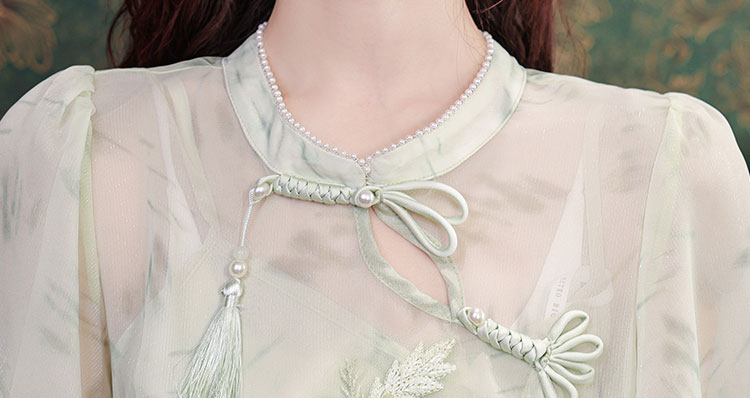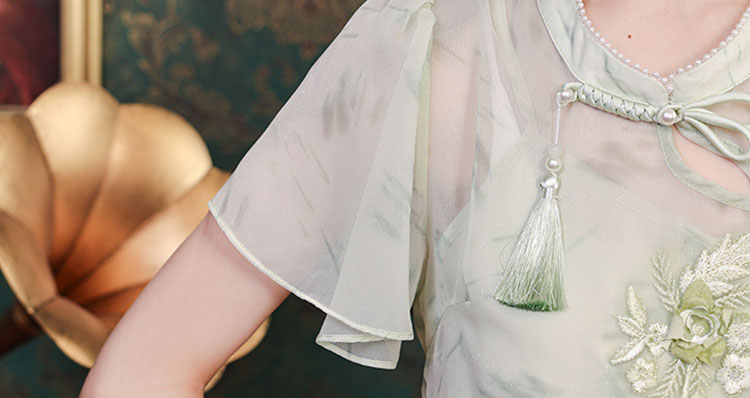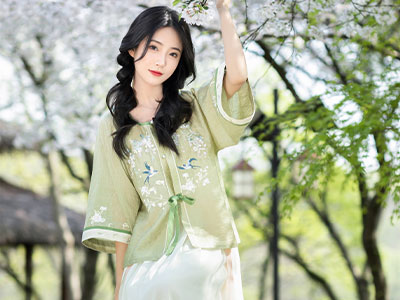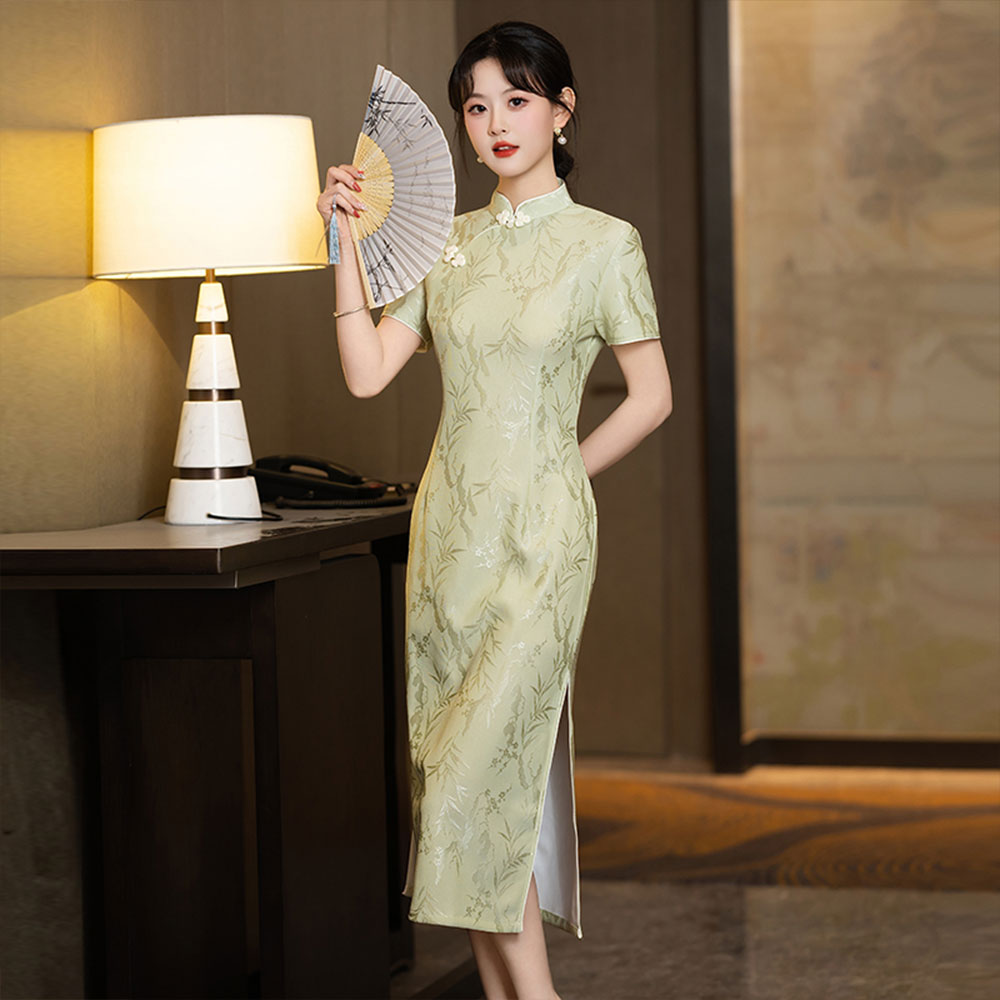At the Spring/Summer 2024 Paris Fashion Week, a show titled “Eastern Poetic Lines” caused a sensation. The grand finale gown from the Italian brand Dolce & Gabbana drew inspiration from the qipao, Making a stunning statement, the high-standing collar slices cleanly across the model’s sharp jawline, while hand-embroidered bamboo branches ripple across silk with every graceful step. The traditional slit transforms into an asymmetrical geometric cut, casting sleek, modern lines beneath the spotlight.
This scene wasn’t an anomaly. From Gucci’s fusion of knotted closures with tailored suits to Prada’s 3D-printed recreations of cloud-patterned trims, designers are boldly reimagining qipao symbolism—bringing it back to the global fashion stage with fresh, subversive energy.
The Origins of the Qipao
The origins of the qipao can be traced back to the 17th century during the Qing Dynasty, when it was worn by Manchu women as part of the traditional “qi-zhuang” (banner clothing). Characterized by its loose, straight-cut silhouette, right-side placket, and rich embroidery, the original qi-zhuang served as the standard attire for women in the Qing imperial court and aristocracy. As the Manchu rulers settled into China, their clothing gradually absorbed elements from Han culture, including wide sleeves and saddle collars.
In the early 20th century, after the fall of the imperial system, tailors in cosmopolitan cities like Shanghai began fusing Western three-dimensional tailoring with traditional qi-zhuang. They introduced innovations such as cinched waists, tapered sleeves, and elevated slits—reshaping the once-modest robe into the modern qipao that celebrated the female form. This evolution signaled a decisive shift: from ethnic tradition to fashion statement, laying the groundwork for the qipao’s return to the global runway.
Design Improvements of the Qipao
The design evolution of the qipao has spanned over a century, with each step from tradition to modernity reflecting a fusion of Eastern and Western aesthetics. In the 1920s, Shanghai tailors were the first to introduce Western three-dimensional tailoring techniques. By cinching the waist, narrowing the hem, and raising the slits, they transformed the once-loose qi-zhuang into a modern garment that accentuated the female form. In the 1950s, Hong Kong designers pioneered the “wave sleeve” and the dartless cut, bringing a lighter, more dynamic quality to the qipao. Contemporary innovations are seen in fabric technologies (such as elastic blends and 3D-printed patterns), deconstructivist designs (asymmetrical hems and detachable accessories), and cross-cultural blends (such as the fusion of qipao with suits and sportswear), allowing this traditional garment to continuously evolve and breathe new life.

Controversies Surrounding the Qipao
Western fashion often interprets the qipao through a lens of Orientalism, falling into the traps of symbolism and exoticism. At the 2015 Met Gala, a luxury brand transformed the qipao into a high-slit, deep-V dress adorned with dragon embroidery—an image that stirred controversy within the Chinese community. This design stripped the qipao of its subtle elegance and reimagined it as an “Oriental fantasy” crafted to satisfy Western curiosity.
More troubling is how some designers selectively borrow features like knotted buttons and mandarin collars while ignoring the deeper tradition of “clothing as a vessel of etiquette.” As scholars have argued, when the qipao is reduced to a decorative “Chinese flavoring” on fashion runways, it erases the garment’s deeper narrative—its century-long role in the liberation and reshaping of the female body.
This kind of misappropriation echoes Edward Said’s critique of Orientalism: it reframes Eastern culture as a stylized motif, a disposable aesthetic that the West can freely reinterpret and commodify.
Cross-Cultural Clashes
In the context of globalization, the qipao has continuously evolved through a dynamic interplay and dialogue between Eastern and Western cultures. Many Western designers attempt to “deconstruct the East” by stripping the qipao’s symbols from their historical roots. In 2019, for instance, a French brand fused the qipao’s high collar with an ultra-short leather skirt and metallic chains—an act that critics condemned for reducing the misty beauty of Jiangnan to nightclub aesthetics.
East Asian designers have responded with more critical approaches. Korean brand Joomi Lim reimagined the qipao’s silhouette using eco-friendly fabrics, kept traditional piping along the shoulders, and deliberately tore the hem to symbolize the cultural rift left by colonial history.
This ongoing clash has sparked new hybrid expressions. At Central Saint Martins in London, fashion students unveiled “digital qipaos” that used projection technology to create real-time ink wash patterns on minimalist white fabrics, challenging the question: “What defines true Chineseness?”
A deeper tension revolves around the struggle for cultural ownership. When the Metropolitan Museum of Art in New York labeled a Republic-era qipao as “Oriental Dress,” members of the overseas Chinese community launched a petition in protest. Meanwhile, young Chinese creators have taken to short video platforms to lead the “New Qipao Movement,” styling cropped qipaos with skateboards and using Gen Z language to reclaim the right to define the qipao. As scholar Homi Bhabha suggests, the qipao’s cross-cultural journey embodies a “third space”—neither a purely Eastern legacy nor a Western fashion accessory, but a new cultural grammar born from ongoing collision and dialogue.

Future Trends and Challenges
Amid the dual waves of sustainable fashion and digital innovation, the qipao is undergoing a profound transformation while grappling with an identity crisis. For instance, biotech fabric labs are now cultivating artificial spider silk that mimics the texture of real silk—potentially redefining the ethical boundaries of qipao materials. At the same time, 3D body scanning combined with AI algorithms is breaking down the barriers of traditional “custom tailoring.” In fact, a Shanghai-based startup has introduced a “10-minute virtual tailor” that uses smartphone cameras to generate precise qipao patterns instantly. However, this leap in technology raises concerns. When holographic qipaos walked the runway at Paris Fashion Week, critics questioned sharply, “Without the silk’s tactile quality and the warmth of handcraft, does the qipao lose its soul?”
Moreover, an even greater challenge emerges from the battle over cultural narratives. As the “New Chinese Style” trend sweeps across global markets, international fast fashion brands are mass-producing qipao-inspired designs, stripping their patterns and cuts of deeper symbolic meaning. In response, Chinese independent designers have adopted “anti-colonial design” strategies. They release traceable qipaos that include QR codes linking to personal migration stories embedded in each pattern. Simultaneously, the metaverse has ignited a new sovereignty conflict over digital qipaos. One virtual design, auctioned as an NFT, sparked outrage after accusations of unauthorized use of Suzhou embroidery, highlighting a fresh struggle over traditional cultural IP in the blockchain era.
Ultimately, the qipao’s future will inevitably walk a tightrope between technological empowerment and cultural preservation. To remain relevant, it must embrace the endless possibilities of the algorithmic age while holding fast to the spiritual DNA that defines it. Between every warp and weft, the qipao continues to express the poetic tension of Eastern aesthetics — a delicate balance between restraint and boldness.
Modern Qipao Shop
Welcome to our Modern Qipao Shop, where traditional craftsmanship meets modern design to create a collection of exquisite and comfortable qipaos. Each piece is made from high-quality fabrics, suitable for various occasions, allowing you to showcase your unique style while honoring tradition. We are committed to offering a diverse range of designs to meet the needs of different customers. Whether classic or innovative, our qipaos will make you feel confident and radiant, highlighting your unique charm.


